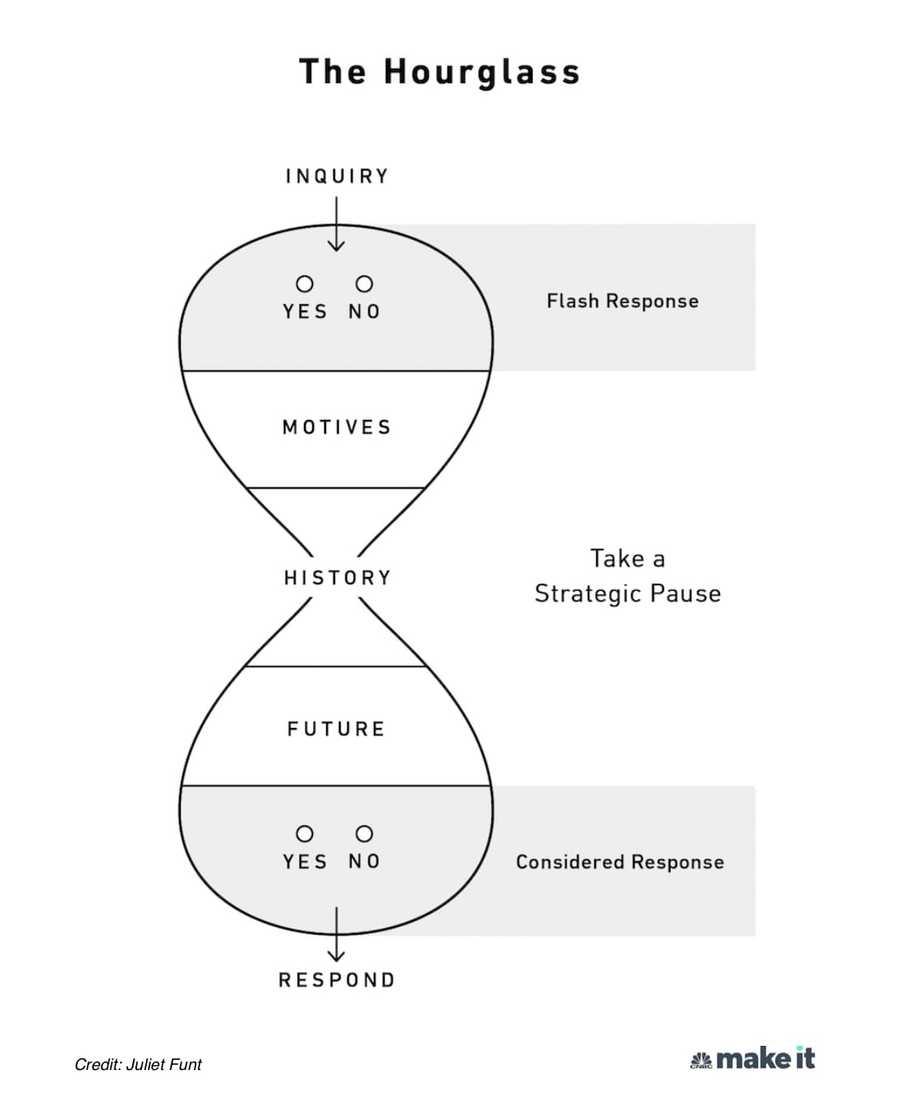The smartest people use a simple model and these 6 phrases to say 'no' when they need to, says CEO—here's how it works
Curated from: cnbc.com
Ideas, facts & insights covering these topics:
6 ideas
·1.68K reads
14
Explore the World's Best Ideas
Join today and uncover 100+ curated journeys from 50+ topics. Unlock access to our mobile app with extensive features.
The smartest people use a simple model and these 6 phrases to say 'no' when they need to
While “no” is a loaded word, it protects your time, energy and focus. Most people sense they need to say it more often, but tense up at the thought of delivering it. Typically, they realize they should have said no only after they failed to do so.
In our jumpy work world filled with hallucinated urgency, we often respond with what I call a “flash response” — an immediate answer to a yes or no request, and is fueled by reflex, impulse and distraction.
Luckily, through years of researching the smartest and most productive employees.
25
380 reads
Saying 'no': How to use the Hourglass method
- At the top of the Hourglass, begin by noting the flash response you initially had to the request: Yes or no? Write down whatever you felt like saying in the moment.
- Next is the critical consideration phase, in which you pause to examine three things: Your motives, your history, and your future.
- Ask yourself if you are enthusiastically accepting an opportunity you want or, conversely, people-pleasing, operating on fear or kissing up. If you're seeking the feeling of being needed, liked or gaining visibility —own that truth.
22
375 reads
Saying 'no': How to use the Hourglass method (cont'd)
- Jot down a few private thoughts about your motives, whether negative or positive.
- Consider next your recent history of similar yes or no choices. Think about if you’ve volunteered too much in the past and felt a pinch of resentment. Also look for where you may have said no to opportunities that left you curious and hankering for involvement. Let your past experiences play into the choice before you.
23
268 reads
Saying 'no': How to use the Hourglass method (cont'd)
- The last step before responding is to consider the future. Project whether your yes or no benefits or harms you or your team days from now. How will your response protect your time and focus? Howwill it impact results? Will it challenge or support your relationships and influence?
- At the base of the Hourglass, it’s time to make your decision and note your considered response. Make a choice, write it down, then deliver it with the confidence bred by the intentionality you’ve shown. (This entire process can shorten to an automatic moment or two once it has become familiar.)
21
199 reads
Example phrases to help you say no
In simple situations, you’ll benefit from the collection of phrases below that can adapt to fit your style.
- “May I take a day to get back to you?”
Buy yourself time to work the Hourglass. When the interpersonal contact is broken, the intellect engages, better quipping you to make rational decisions. - “I can do it for you this time, but I can’t do it for you every time.
Ease a demanding person back slowly from their expectations, and set up a future no. - “It does not [or will not] work for me to ... ”
This clause is a marvelous neutral beginning to any no. Be cautious of harshness in your tone
29
225 reads
Example phrases to help you say no (cont'd)
- I can’t, but here’s another option for you.” Share an alternative or suggestion in place of you being able to help.
- “It’s not good for me now, but let’s look ahead in our calendars.” Be careful not to use a delay to avoid a necessary no. Of course, if timing is really the issue, then push the commitment back.
- “Sorry, no.” Yes, this is a complete sentence. Get it out and say nothing more.
28
242 reads
IDEAS CURATED BY
Krazy Kid's ideas are part of this journey:
Learn more about career with this collection
Effective communication with remote employees
Strategies for building trust and accountability
Techniques for managing remote teams
Related collections
Similar ideas
2 ideas
11 ideas
Read & Learn
20x Faster
without
deepstash
with
deepstash
with
deepstash
Personalized microlearning
—
100+ Learning Journeys
—
Access to 200,000+ ideas
—
Access to the mobile app
—
Unlimited idea saving
—
—
Unlimited history
—
—
Unlimited listening to ideas
—
—
Downloading & offline access
—
—
Supercharge your mind with one idea per day
Enter your email and spend 1 minute every day to learn something new.
I agree to receive email updates



